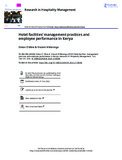| dc.contributor.author | Were, Simon O | |
| dc.contributor.author | Maranga, Vincent N | |
| dc.date.accessioned | 2023-01-10T05:44:13Z | |
| dc.date.available | 2023-01-10T05:44:13Z | |
| dc.date.issued | 2022-11-21 | |
| dc.identifier.uri | https://doi.org/10.1080/22243534.2022.2133069 | |
| dc.identifier.uri | https://www.tandfonline.com/doi/abs/10.1080/22243534.2022.2133069 | |
| dc.identifier.uri | http://ir-library.mmust.ac.ke:8080/xmlui/handle/123456789/2144 | |
| dc.description.abstract | This study investigated the efficacy of hotel facilities’ management practices on employee performance. A descriptive research survey was applied, while the study area was Nairobi County. The sampling techniques applied were a census, stratified, purposive and simple random sampling which gave a sample size of 144 employees. Study results show that sufficient lighting to allow ease of working and moving around safely gave the highest mean value among maintenance management factors (3.95), while work surfaces and head-height beams yielded the highest mean (3.95) among hotel workplace design factors. Nonetheless, health and safety had the majority (40%) of respondents among the hotel facilities regulations and standards. Finally, hotel maintenance management gave the greatest contribution in the relationship between hotel facilities management practices and employee performance (Β = 0.572, t = 4.637, p < 0.001), while hotel workplace design gave the least contribution (B = −0.299, t = −2.576, p = 0.011). | en_US |
| dc.language.iso | en | en_US |
| dc.publisher | Research in Hospitality Management | en_US |
| dc.subject | Hotel, facilities, management, practices, employee, performance | en_US |
| dc.title | Hotel facilities’ management practices and employee performance in Kenya | en_US |
| dc.type | Article | en_US |

